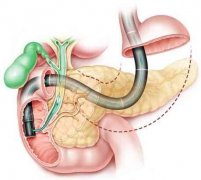
2型ERCP相关腹膜后十二指肠穿孔的非手术治疗:一项9年单中心的经验
背景:关于ERCP相关腹膜后的十二指肠穿孔的治疗并没有共识,本研究的目的是探索ERCP术后腹膜的十二指肠壶腹周围穿孔(2型)经保守治疗的临床效果。
方法:将曾于2009年1月1日至2017年12月31日就诊我院行ERCP的患者作为纳入对象,收集任何腹膜后十二指肠壶腹周围穿孔(2型)的资料。相关资料包括(患者特征,适应症,影像学表现,诊断和手术时间,手术方式,住院时间和愈后)进行回顾性收集和记录,将结果与现有文献进行对比。
结果:在过去9年中收集的4196例行ERCP的患者中,发现24例患者发生腹膜后2型十二指肠穿孔。ERCP适应症为:胆总管结石,梗阻性黄疸和壶腹周围肿瘤。大多数患者(21/24, 87.5%)在术后12小时内诊断(通过CT影像),术中诊断(3/24,12.5%)。12例患者(50%)病情加剧,采用CT引导下经皮穿刺引流。2例患者经外科手术干预(8.3%)。总死亡率为4.2%,1/24(1例患者外科手术后死亡)。
结论:腹膜后十二指肠穿孔是非常罕见和严重的ERCP并发症。然而,在大多数情况下,保守治疗是安全有效的。
Non-Operative Management of Type 2 ERCP-Related Retroperitoneal Duodenal Perforations: A 9-Year Experience From a Single Center
Vasileios Theopistos , Georgios Theocharis , Christos Konstantakis, et al. Gastroenterol Res. 2018;11(3):207-212
Background: No consensus exists on treatment of endoscopic retrograde cholangiopancreatography (ERCP) -related, retroperitoneal duodenal perforations. The aim of this study is to determine the incidence of post-ERCP retroperitoneal periampullary (type 2) duodenal perforations and the clinical outcome of non-surgical management.
Methods: Patients who underwent ERCP in our institution during the period from January 1, 2009 to December 31, 2017 were included. Any cases of retroperitoneal periampullary duodenal (type 2) perforation were identified. Relevant data (patient characteristics, indications, radiographic findings, time to diagnosis and surgery, surgical procedures, hospital stay and outcome) were retrospectively collected and reviewed. Results were compared to those from the existing literature.
Results: There were 24 patients with retroperitoneal type 2 duodenal perforation following 4,196 ERCPs were identified (24/4196, 0.57%) over the 9-year period. ERCP indications were: choledocholithiasis, obstructive jaundice and ampullectomy (ampullary adenoma). Diagnosis (aided by CT scan) was established within the first 12 h in the majority of patients (21/24, 87.5%) and intraprocedural in3/24, (12.5%). Twelve patients (50%) with deteriorating clinical course were managed with CT-guided percutaneous drainage. Surgical intervention was required in two (8.3%). Overall mortality was 4.2%, 1/24(one patient died after surgery).
Conclusions: Retroperitoneal duodenal perforation is a rare and severe ERCP complication. However, conservative management is feasible in the majority of cases.
翻译:张卫 校审:张立超 侯森林



